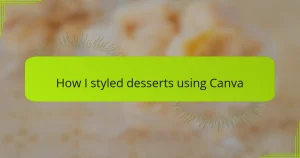Key takeaways
- Food styling involves meticulous attention to detail, using tools like tweezers and brushes to create visual balance and enhance the story of desserts.
- Key techniques include focusing on contrast, layering elements for height, and utilizing negative space for an elegant presentation.
- Patience and trust in your instincts are crucial, allowing for a calm approach that transforms dessert styling into an art form.
- Styling enhances the overall experience by harmonizing visual appeal with flavor, encouraging thoughtful placement and experimentation with colors and textures.
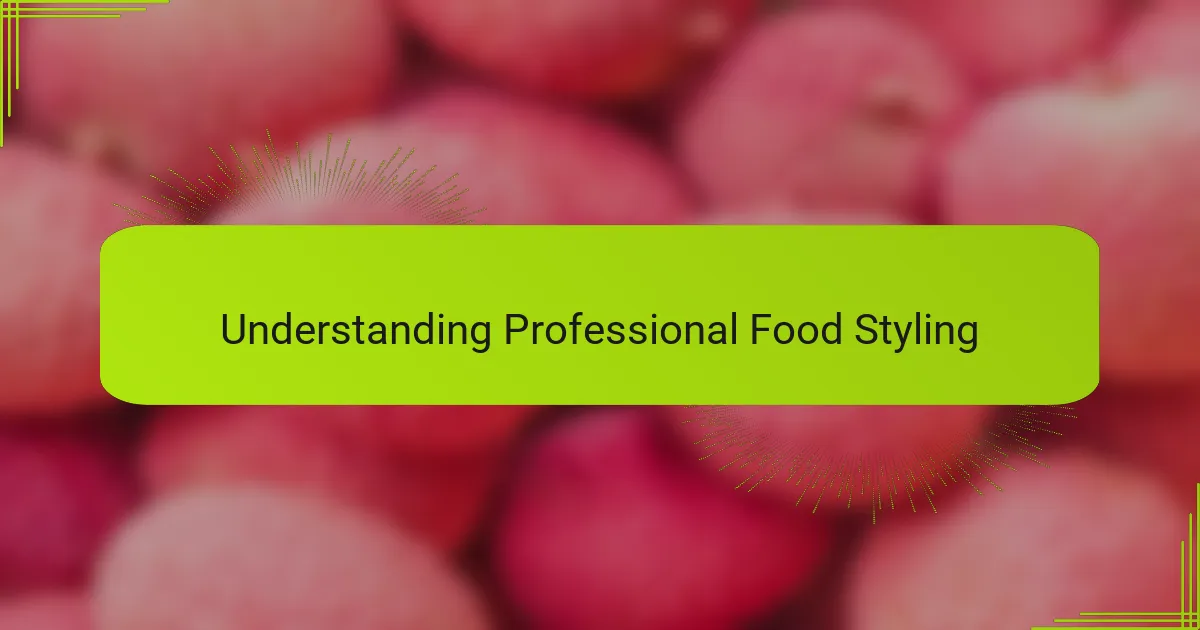
Understanding Professional Food Styling
When I first encountered professional food styling, I was struck by how much thought goes into every tiny detail. It’s not just about making food look good—it’s about telling a story through colors, textures, and arrangement. Have you ever wondered why some desserts instantly grab your attention? That’s the magic of styling.
What surprised me the most was the use of unconventional tools and tricks. For instance, I learned that toothpicks or tweezers often help position delicate elements perfectly. This level of precision made me appreciate how much patience and creativity food stylists pour into their work.
Understanding these techniques changed the way I viewed my own dessert creations. Instead of rushing to plate, I started to think about balance, lighting, and even the background. It made me realize that styling isn’t just an add-on—it’s an essential part of making desserts irresistible.

Essential Tools for Food Styling
When I first got serious about food styling, I quickly realized that having the right tools makes all the difference. Simple items like offset spatulas and fine brushes help me delicately spread sauces or dust powdered sugar without smudging the dessert’s surface. Have you ever tried to get that perfect drizzle or sprinkle? Trust me, a good brush feels like an extension of your hand.
Another tool I never expected to rely on so much is a pair of tweezers. They might look unusual for the kitchen, but they’re invaluable for placing tiny garnishes exactly where I want them. Early on, I found myself fumbling with my fingers, accidentally crushing fragile ingredients—tweezers save me from those small disasters and keep the composition clean and elegant.
I also can’t overlook the power of a blowtorch or heat gun, especially when working with textures like meringue or caramel. Using these allowed me to add just the right amount of color and crispiness without overcooking anything. It made me think: how do these tools shape the story my desserts tell visually? From my experience, they bring a touch of professionalism that instantly elevates the final presentation.
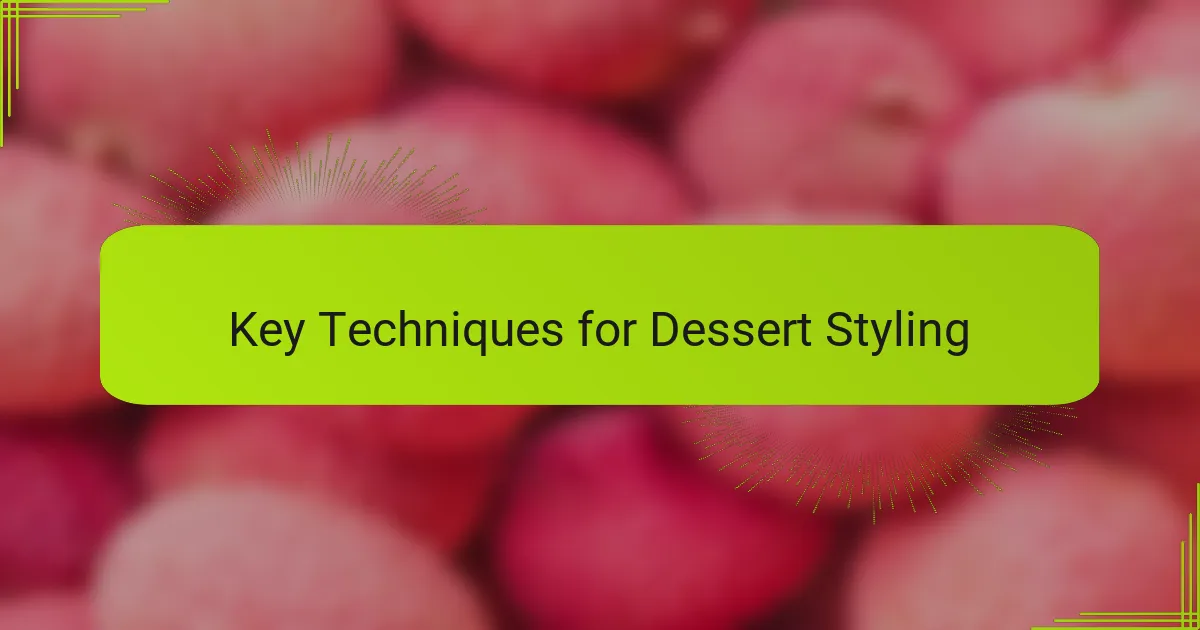
Key Techniques for Dessert Styling
One technique that completely changed my approach was focusing on contrast—both in color and texture. I remember plating a panna cotta and adding a sprinkle of bright raspberry coulis alongside crunchy pistachio crumbles. That balance not only made the dessert visually striking but also created an exciting experience for the palate. Have you noticed how contrasting elements can turn something simple into something memorable?
Another key technique I swear by is layering. Building height and dimension instead of just spreading everything flat adds drama to the plate. For instance, stacking delicate macarons with dollops of whipped cream and edible flowers transformed a basic tray into a miniature work of art. From my experience, playing with layers invites the eye to explore every detail, making the dessert feel more luxurious.
Lastly, I’ve learned the importance of negative space—the areas left intentionally empty. Early on, I used to crowd every inch of the plate, thinking more meant better. But stepping back, I realized that breathing room helps each component shine individually. It’s like giving your dessert a stage to perform on rather than overwhelming it with accessories. Have you ever tried stepping back and simply letting your dessert speak? It’s surprisingly effective.
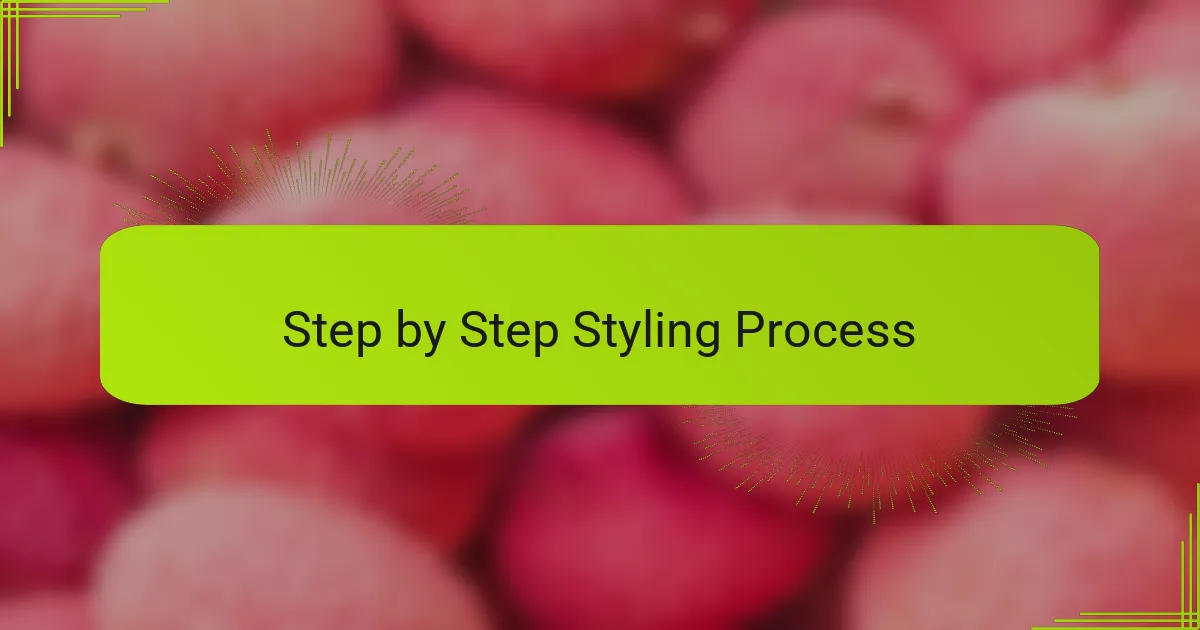
Step by Step Styling Process
Starting with the foundation, I always begin by setting the scene—choosing the right plate and background that will highlight the dessert’s colors and textures. It might seem simple, but this first step often sets the tone for the entire styling process. Have you ever noticed how a plain white plate can transform the look of a colorful tart?
Next, I move on to arranging the main elements carefully, using tools like tweezers to place tiny garnishes exactly where I want them. I learned early on that patience here pays off; rushing just leads to smudges or awkward spacing. There’s a quiet satisfaction in seeing each component click together, almost like piecing together a puzzle.
Finally, I focus on the finishing touches—drizzling sauces with a fine brush or dusting powdered sugar with precision to add that professional polish. I often ask myself, does this little detail enhance the story I’m telling or just clutter the plate? From experience, knowing when to stop is as important as knowing where to start.
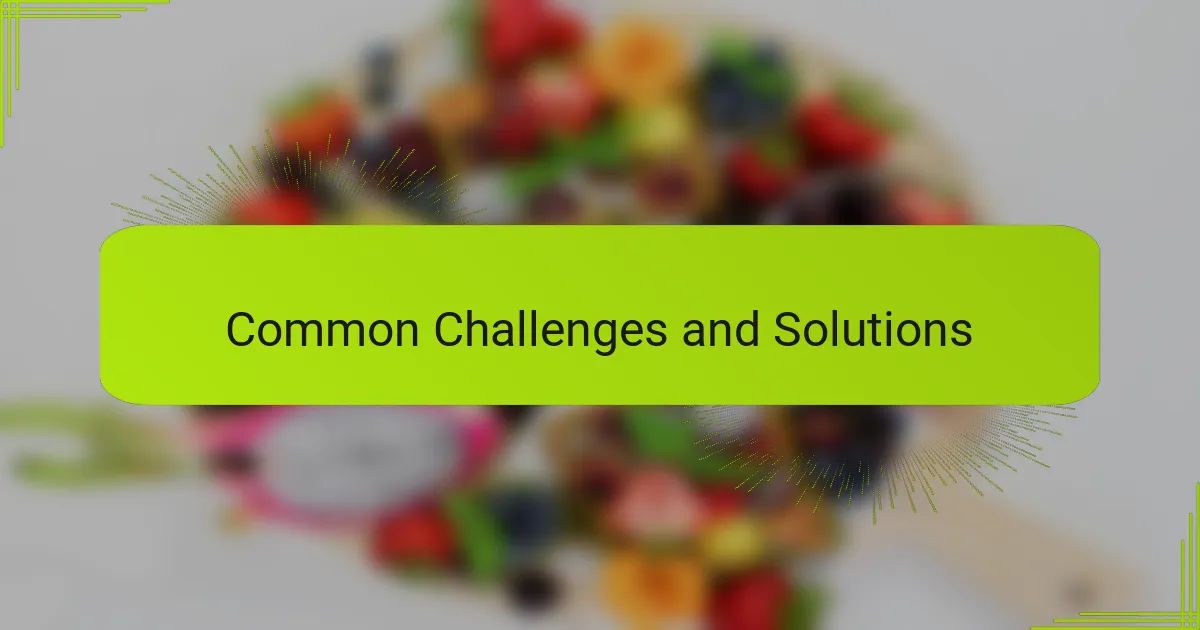
Common Challenges and Solutions
One challenge I often faced was keeping delicate garnishes intact while positioning them. Early on, I would fumble with my fingers and accidentally crush tiny edible flowers or fragile crumbs. Tweezers became a game changer—they allowed me to place these elements gently, which saved me from many frustrating moments.
Another common hurdle is balancing spontaneity with precision. I’ve caught myself rushing through the styling, wanting to capture the shot before the dessert lost its freshness. But I quickly learned that taking a breath and moving slowly prevents smudges and uneven spacing. It’s like building a puzzle—each piece needs care to create a beautiful final picture.
Have you ever struggled to know when to stop adding decorations? I sure have. It’s tempting to pile on sauces, sprinkles, and fruit, thinking “more is better,” but that often leads to a crowded plate. Over time, I’ve realized that embracing negative space and restraint actually makes the dessert feel more elegant and inviting. Sometimes, less truly is more.
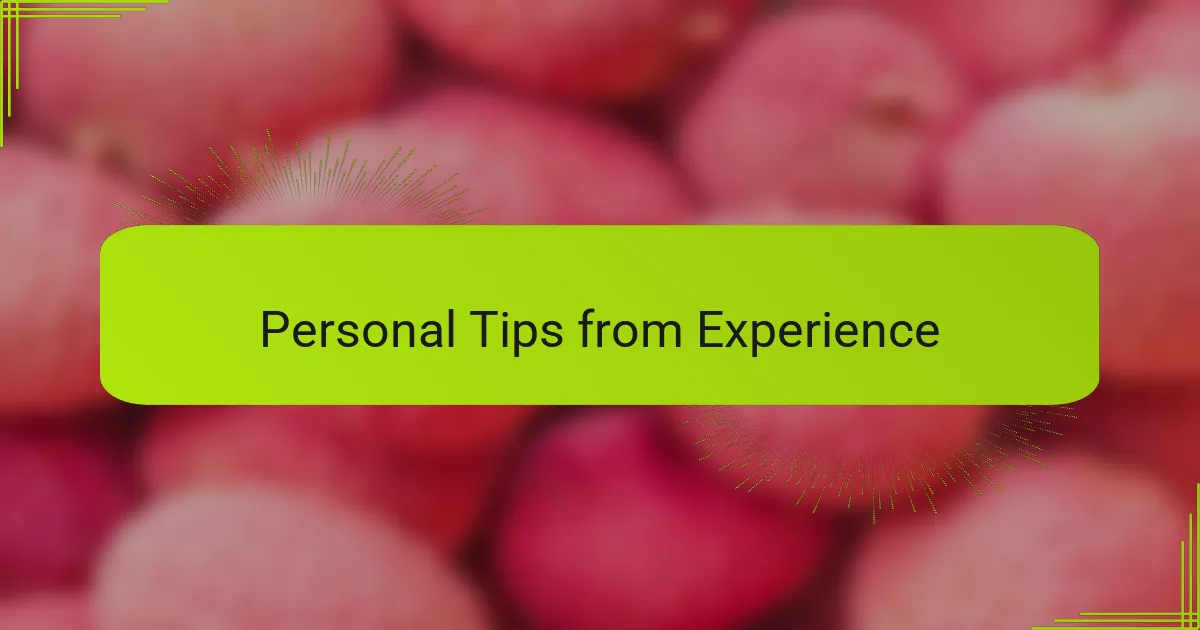
Personal Tips from Experience
One tip I’ve found invaluable is to trust your instincts while styling. There were moments when I questioned whether a plate looked balanced or if the colors complemented each other. But over time, I learned to listen to that initial feeling—if something feels off, it usually is. Have you ever paused and just stepped back to see your work from a fresh perspective? That little moment often saved me from styling mistakes.
Another practice I swear by is embracing imperfection. Early in my journey, I aimed for flawless presentations, which only made me anxious and slowed me down. Then I realized that a tiny drip of sauce or a slightly tilted garnish adds character and makes the dessert feel alive. It’s those small, human touches that connect with people more than sterile perfection ever could.
Lastly, patience is everything. I used to rush through the plating, eager to photograph before the dessert lost its charm. But slowing down changed everything. Taking deliberate, gentle movements helped me avoid smudges and made styling feel more like an art than a chore. Have you noticed how a calm, focused approach can turn a simple dessert into something spectacular? From experience, it truly transforms the whole process.
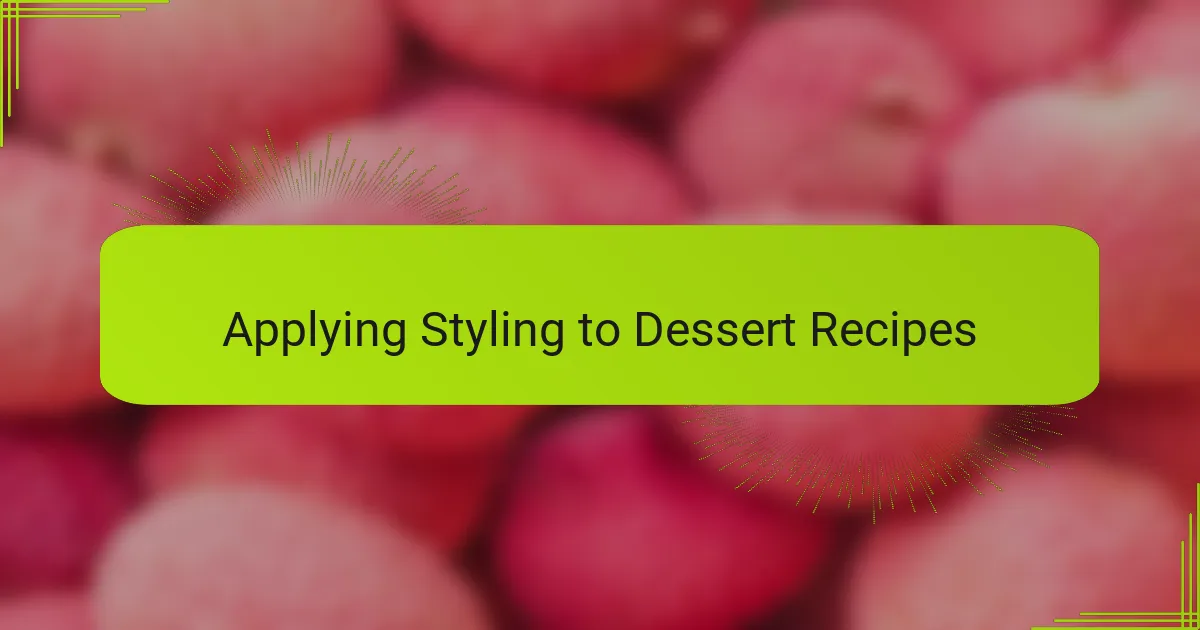
Applying Styling to Dessert Recipes
Applying styling to dessert recipes has been a transformative part of my baking journey. I quickly realized that styling goes beyond just placing ingredients—it’s about creating a visual harmony that complements the flavors. Have you ever found yourself hesitating before adding that final garnish? That moment of decision is where styling truly comes alive.
When arranging desserts, I pay close attention to balance and spacing. Early on, I struggled with overcrowding my plates, thinking more decorations meant better presentation. But stepping back taught me that thoughtful placement and leaving some breathing room make each element stand out beautifully, making the whole dish inviting rather than overwhelming.
Another habit I developed was experimenting with textures and colors to enhance appeal. For example, pairing a smooth chocolate mousse with vibrant fresh berries and a sprinkle of delicate edible flowers not only looks stunning but also adds layers of interest. Don’t you think a dessert that engages both the eyes and palate creates a more memorable experience? From my perspective, that synergy is what turns a simple dessert into a piece of art.




